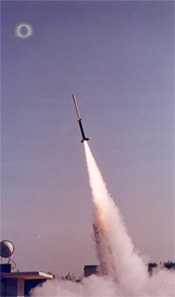India launched a small fleet of rockets to monitor the effects of the annular solar eclipse that occurred today. A total of 11 Rohini sounding rockets – suborbital rockets designed for scientific experiments – were launched from several different sites, including the Satish Dhawan Space Centre (SDSC) in Sriharikota. These rockets, launched by the Indian Space Research Organization (ISRO), carried instruments to measure the effect the eclipse had on the Earth’s atmosphere.
The eclipse – which lasted 11 minutes and 8 seconds at its peak, was visible to observers in Africa, southern Asian countries, India and China. This was an annular eclipse, meaning that the Moon blocked the Sun’s light enough for a bright ring to be seen around the silhouette of the Moon, and was the longest such eclipse of the millennium.
There are several phenomena that take place in the lessening of the Sun’s rays during an eclipse. When the solar radiation drops during an eclipse, the ionization that occurs in the atmosphere is temporarily lowered, causing disruptions in the Equatorial Electrojet – a ribbon of electric current that flows east to west near the equator.
The temperature and wind of the atmosphere are also altered by the cessation of sunlight, and were measured by the rockets. India launched five rockets yesterday to record pre-eclipse data, and then six more were launched today to measure the changes after the eclipse, which peaked at 1:15pm local time. Over 90% of the Sun’s light was blocked near the Thumba Equatorial Rocket Launching Station (TERLS), which lies on the southern tip of India, and was well-placed to measure the eclipse.
“Results of these experiments will coordinate ground-based eclipse observations with in situ space measurements. Interpretation of eclipse data together with space data is expected to give new insights to the earlier eclipse observations,” the ISRO wrote in a press release.
Sounding rockets have been used by other space agencies to monitor the ionosphere and the role of the Sun in atmospheric phenomenon. In 1994, NASA cooperated with Brazil on the Guara Campaign, named after the Guara bird that is native to Brazil. In August-October of that year, NASA launched a total of 33 rockets with various experiments to measure the photochemistry and plasma of the atmosphere near the equator. All of the rockets were launched from the Alcantara launch range in Brazil.
Source: ISRO press release


At third and sixth paragraphs, the term should be phenomena, which is plural, not “phenomenon”, which is singular.
I wonder if any imagery was captured of the event from the ISS? I hear weather predictions for the eclipse from LEO were great. 🙂
But, uh, seriously, anyone know?
I should have specified, any shots of the lunar shadow on the Earth from the ISS, though shots of the eclipsed sun would be great (and rare).
@IVAN3MAN: Have you grabbed your coat yet? The door is closing.
@ William928,
Not yet… I just noticed, in the second paragraph, the parenthetical clause, “which lasted 11 minutes and 8 seconds at its peak”, should be marked off with either a pair of dashes or a pair of commas.
Um… I’ll now get my coat and see myself out… 😉